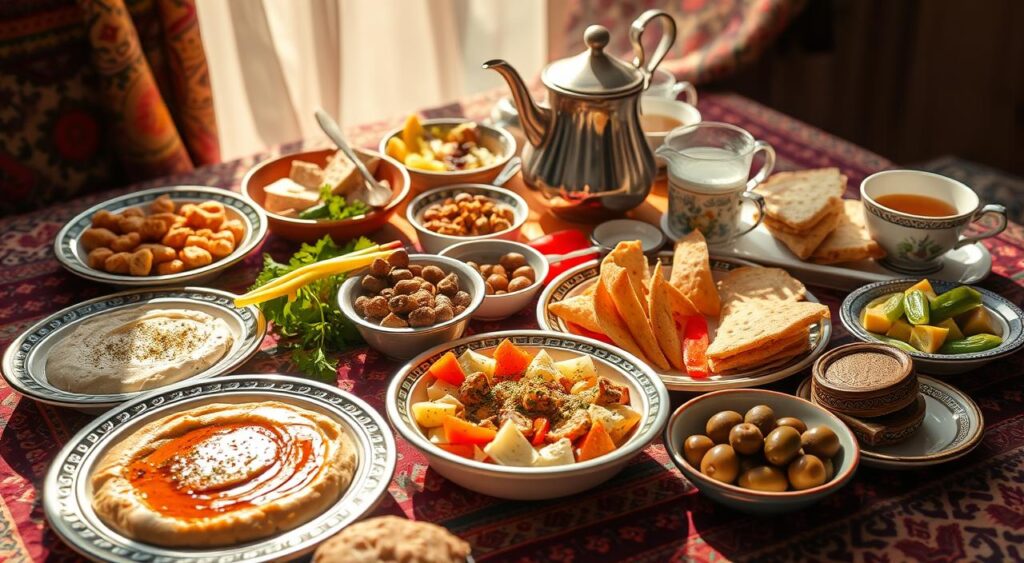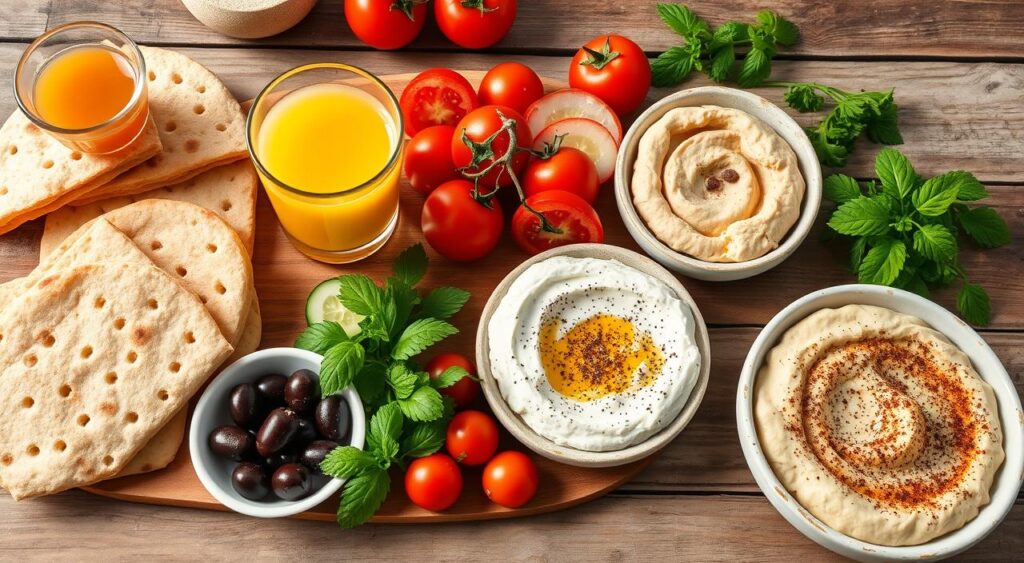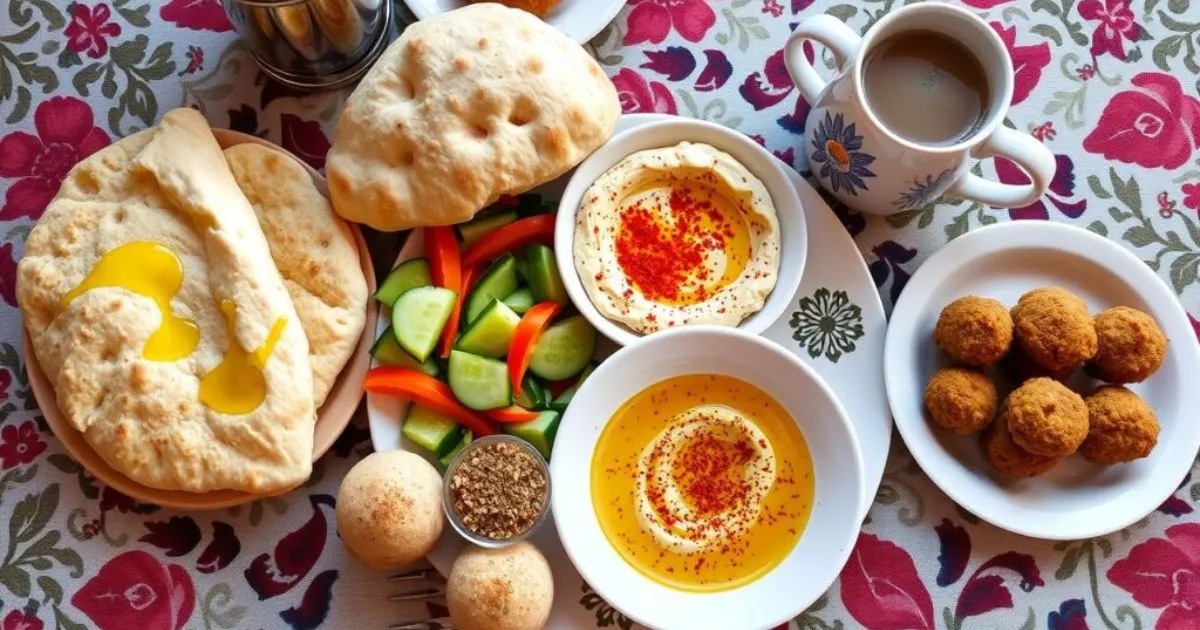Table of Contents
Dive into the rich culinary traditions of the Middle East with Arabic breakfast dishes. These dishes range from hearty and savory to sweet and indulgent. They offer a delightful taste of the region’s vibrant morning meals.
Discover the cultural significance and regional variations that make Arabic breakfast unique. It’s a truly flavorful experience.
Key Takeaways
- Explore the diverse world of traditional Arabic breakfast food recipes
- Understand the cultural significance and social aspects of Arabic breakfast traditions
- Learn about the regional variations in Middle Eastern breakfast cuisines
- Discover the essential ingredients and preparation methods for popular Arabic breakfast dishes
- Appreciate the healthy and authentic components of a typical Arabic breakfast spread
Introduction to Arabic Breakfast Culture and Traditions
In the vibrant tapestry of Arabic culture, breakfast is a cherished tradition. It’s more than just a meal. The arabic breakfast brings families and communities together, creating a sense of belonging and shared identity.
The Social Significance of Arabic Breakfast
In the Middle East, the arab breakfast is a ritual of hospitality and camaraderie. It’s a time to share stories and enjoy flavors passed down through generations. Family members and guests come together, creating a lively atmosphere.
Regional Variations Across the Middle East
The arabic breakfast has a common foundation but varies by region. From shakshuka in North Africa to foul medames in the Levant, each place has its own unique dishes. This shows the diversity and richness of the region’s food heritage.

From the cardamom-infused coffee of the Arabian Peninsula to the manakish breads of the Levant, each dish has its own story. They reflect the land, people, and cultural tapestry that unite the region.
Essential Ingredients for Arabic Breakfast Food Recipes
Starting to make arabic breakfast food recipes means knowing the key ingredients. These are what make Middle Eastern food so vibrant. From chickpeas to spices, mastering these elements is key to making breakfasts that feel like home.
Chickpeas, or garbanzo beans, are at the heart of many dishes. They add a creamy texture and a nutty taste to favorites like foul medames. Fava beans also play a big role, bringing an earthy flavor and a satisfying crunch to breakfasts.
Olive oil is another must-have, used for sautéing and adding depth to sauces. Tahini, made from sesame seeds, adds a nutty flavor and creamy texture to dips and spreads.
The final touch comes from herbs and spices. These add complexity and vibrancy to arabic breakfast food recipes. Ingredients like cumin, coriander, paprika, and za’atar are common. Za’atar, a mix of thyme, sumac, and sesame seeds, gives dishes a unique flavor.
| Key Ingredient | Culinary Use | Sourcing Tips |
|---|---|---|
| Chickpeas | Stews, dips, spreads | Available in most grocery stores, either canned or dried |
| Fava Beans | Stews, salads | Often found in Middle Eastern or specialty grocery stores |
| Olive Oil | Sautéing, dressings, dips | Look for high-quality extra virgin olive oil |
| Tahini | Dips, sauces, spreads | Available in the international aisle or Middle Eastern markets |
| Cumin, Coriander, Paprika, Za’atar | Seasoning, flavor enhancers | Seek out specialty spice shops or Middle Eastern grocers |
With these ingredients, you’re ready to make delicious arabic breakfast food recipes. They’ll take you on a journey to the lively markets and family gatherings of the Middle East.

Traditional Foul Medames Recipe: The Middle Eastern Breakfast Staple
In the Middle East, Foul Medames is the top breakfast dish. It’s a fava bean stew loved by many. From Lebanon to Egypt, its smell fills the air, inviting everyone to enjoy its flavors.
Preparing the Perfect Fava Beans
To make Foul Medames, start by soaking fava beans overnight. Then, drain and rinse them. Simmer them until they’re soft and creamy. This step is key for the dish’s rich texture.
Customizing Your Foul Medames
- While the classic recipe is simple, you can add garlic, cumin, or chili peppers for extra flavor.
- For creamier beans, mash some in the pot or blend a bit of the mixture.
- Try different toppings like tomatoes, onions, eggs, or sumac to add texture and taste.
Serving Suggestions and Garnishes
Traditionally, serve Foul Medames with arabic bread. For a full Lebanese breakfast, add labneh, parsley, and lemon juice.
| Nutritional Benefits | Serving Size | Calories | Protein | Fiber |
|---|---|---|---|---|
| Foul Medames is packed with protein, fiber, and carbs. It’s a healthy way to start your day. | 1 cup | 220 calories | 12g | 9g |
Authentic Shakshuka: A North African Breakfast Classic
Get ready for a flavorful adventure with Shakshuka, a beloved arabic breakfast dish. It’s a North African favorite that’s also a hit at middle eastern brunch gatherings. It’s loved for its rich flavors and satisfying taste.
Shakshuka comes from Tunisia and is a colorful, one-pan meal. It has poached eggs in a spiced tomato sauce. Its simplicity and flexibility have made it a favorite in many homes.
To make the best Shakshuka, start by cooking onions and bell peppers in a skillet. Add warm spices like cumin, paprika, and cayenne. These spices create the sauce’s distinctive flavor. Next, carefully add fresh eggs into the tomato mixture. Let them cook until the whites are set and the yolks are still soft.
Shakshuka is all about personal touch. You can make it saucy or chunky, depending on your preference. Try adding feta cheese, olives, or greens to make it your own.
Serve shakshuka hot, paired with some crusty bread or warm pita for dipping. The mix of savory tomato sauce and soft eggs is a treat. It’s a breakfast that will make you want more.
Whether you’re having a middle eastern brunch or just want a great breakfast, Shakshuka is a must-try. It brings the flavors of North Africa right to your table.
Arabic Breakfast Bread Varieties and Recipes
Bread is key in Arabic cuisine, especially for breakfast. You’ll find everything from fluffy Khubz to savory Manakish. These breads are perfect for a hearty morning meal.
Making Fresh Khubz Arabic Bread
Khubz, or Arabic flatbread, is a favorite in many homes. You need flour, water, yeast, and salt to make it. Start by proofing the yeast, then knead the dough until it’s smooth.
Let it rise, then shape into small balls and flatten them. Bake until it’s golden and puffed. This makes a great base for dipping into stews or spreads.
Traditional Manakish Preparation
- Manakish is a beloved Arabic breakfast bread with many toppings. Begin by mixing flour, yeast, and water to form a soft dough.
- Knead the dough until it’s smooth, then let it rise. Divide it into small portions and flatten each into a round disc.
- Top the Manakish with your favorite ingredients like za’atar, cheese, or ground meat. Bake until the crust is golden and toppings are melted.
Whether you like Khubz or Manakish, these breads are a delicious way to start your day.
| Bread Variety | Key Ingredients | Preparation | Typical Toppings |
|---|---|---|---|
| Khubz | Flour, water, yeast, salt | Proofed yeast, kneaded dough, baked until lightly golden | N/A (served plain or with dips) |
| Manakish | Flour, yeast, water | Kneaded dough, flattened into discs, baked with toppings | Za’atar, cheese, ground meat |
Creamy Labneh: Arabic Breakfast Spread Recipe
Explore the world of Arabic breakfast with creamy labneh spread. This yogurt-based cheese is a key part of lebanese breakfast food. It brings a rich taste to your mornings.
To make perfect labneh, start by straining full-fat plain yogurt. Use cheesecloth or a fine-mesh strainer. This step gets rid of excess whey, making it thick and spreadable. Add a pinch of salt and a squeeze of lemon juice to taste.
- Use high-quality, full-fat yogurt for the creamiest labneh.
- Allow the yogurt to strain for at least 12 hours, or up to 24 hours, for a thicker, more concentrated spread.
- Experiment with herbs, spices, or minced garlic to create unique flavor profiles.
Serve your homemade labneh with freshly baked arabic breakfast breads like pita or manakish. It’s also great on toast, bagels, or as a topping for lebanese breakfast food dishes. For a fuller meal, mix labneh with chopped veggies, olives, and olive oil.
Try the art of lebanese breakfast food with creamy labneh. Enjoy it alone or as part of a spread. This versatile cheese will surely please your taste buds and take you to the Middle East.
Arabic Breakfast Food Recipes for Special Occasions
Arabic breakfast recipes are special during holidays and family gatherings. They bring a sense of cultural heritage and community to our meals. These dishes are filled with tradition and flavor.
Holiday Breakfast Dishes
On holidays, Arabic families gather for breakfast. They enjoy dishes like Fatteh, with its layers of pita, chickpeas, and yogurt. Balila is also popular, a bowl of chickpeas with garlic, lemon, and spices, served with Arabic bread.
Weekend Family Breakfast Spreads
Weekends in Arabic homes are for exploring new recipes. Breakfast spreads include sweet treats like ma’amoul pastries and savory dishes like kunafa. They also have atayef pancakes with sweet syrup.
| Dish | Description | Significance |
|---|---|---|
| Fatteh | Layered dish of crisp pita, chickpeas, yogurt, pine nuts, and spices | Traditionally served during religious holidays and celebrations |
| Balila | Boiled chickpeas seasoned with garlic, lemon, and warm spices | A comforting and nourishing breakfast staple |
| Ma’amoul | Shortbread pastries filled with dates, nuts, or other sweet fillings | Commonly enjoyed during Eid festivals and special occasions |
Exploring Arabic holiday breakfasts or weekend spreads is a treat. These recipes show the rich heritage of the Middle East. Enjoy meals and create memories with the ones you cherish.
Healthy Mediterranean Breakfast Components
The Mediterranean diet is full of healthy and tasty options for arabic breakfast and middle eastern breakfast. These meals include fresh fruits and veggies, whole grains, and plant-based proteins. They make for a nutritious and fulfilling start to your day.
Fresh veggies are a must in a healthy arabic breakfast. Add tomatoes, cucumbers, bell peppers, and leafy greens to your plate. These foods are packed with vitamins, minerals, and antioxidants that boost your health.
Whole grains like khubz (Arabic bread) or manakish are key in a balanced middle eastern breakfast. They give you long-lasting energy and fiber. This helps with digestion and supports a healthy weight.
- Add fresh herbs and spices, like parsley, mint, and za’atar, to your arabic breakfast for extra flavor and nutrition.
- Choose plant-based proteins, like labneh (strained yogurt) or hummus, for a complete breakfast that’s rich in nutrients.
By using these Mediterranean-inspired ingredients, you can make arabic breakfast and middle eastern breakfast dishes that are both tasty and healthy. They support your overall well-being.
Arabic Breakfast Beverage Recipes
Enjoying a fragrant cup of Arabic coffee or a cool glass of mint tea is key to the Arabic breakfast. These drinks not only delight the taste buds but also carry deep cultural meaning. They bring people together, creating a sense of community and warmth.
Traditional Arabic Coffee Preparation
Making the perfect Arabic coffee, or “gahwa,” is an art that blends skill and tradition. Begin with finely ground, top-quality Arabica beans and a special pot called a “dallah.” Heat the water and coffee mix slowly, letting the flavors combine before pouring into small cups.
The addition of cardamom pods gives the coffee a unique floral scent. This enhances the overall taste experience.
Mint Tea Serving Customs
Mint tea, or “na’na,” is a beloved part of Arabic breakfasts. It’s made with green tea leaves from the Middle East and fresh mint. The tea is poured from high up to create a creamy foam on top.
Drinking mint tea is a special occasion. It’s often enjoyed with friends and family, sparking lively conversations and the sharing of stories.
FAQ
What are some popular Arabic breakfast food recipes?
Popular Arabic breakfast dishes include Foul Medames (fava bean dish) and Shakshuka (eggs in spiced tomato sauce). You’ll also find Labneh (strained yogurt cheese) and traditional breads like Khubz and Manakish.
What is the cultural significance of Arabic breakfast?
Arabic breakfast is deeply rooted in culture and family. It’s a time for family to come together and share traditions. It sets the day’s tone and is a symbol of hospitality.
What are the key ingredients used in Arabic breakfast dishes?
Arabic breakfasts often feature chickpeas, fava beans, and olive oil. Tahini, herbs, and spices are also common. Fresh produce like tomatoes and parsley add flavor and freshness.
How do I make the perfect Foul Medames?
To make Foul Medames, soak and cook fava beans. Season with garlic, lemon, and spices. Serve with parsley, tomatoes, and olive oil.
What is Shakshuka and how do I prepare it?
Shakshuka is eggs poached in a tomato and pepper sauce. Sauté onions, peppers, and tomatoes first. Then, crack eggs into the sauce and simmer until cooked.
What types of bread are commonly served for Arabic breakfast?
Arabic breakfasts often include Khubz (flatbread) and Manakish (topped with za’atar or cheese). Making these breads at home adds authenticity to your meal.
How do I make creamy Labneh for my Arabic breakfast?
To make Labneh, strain full-fat yogurt until thick. Season with salt, garlic, and herbs. Serve as a dip or spread.
What are some special occasion Arabic breakfast dishes?
For special occasions, try Fatteh (chickpeas, bread, and meat) and Balila (chickpea and herb salad). These dishes are made with care and hold cultural significance.
How can I create a healthy Arabic breakfast?
For a healthy Arabic breakfast, choose whole grains and plant-based proteins. Include fresh produce and healthy fats. Try whole-wheat Khubz, Shakshuka, and Labneh or hummus.
What are the traditional Arabic breakfast beverages?
Traditional drinks include strong Arabic coffee and fragrant mint tea. These beverages are prepared with care and hold cultural significance.

